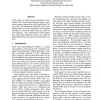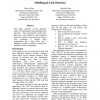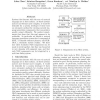COLING
2002
13 years 11 months ago
2002
In this paper we report on our experiments on automatic Word Sense Disambiguation using a maximum entropy approach for both English and Chinese verbs. We compare the difficulty of...
COLING
2002
13 years 11 months ago
2002
This paper presents a maximum entropy-based named entity recognizer (NER). It differs from previous machine learning-based NERs in that it uses information from the whole document...
COLING
2002
13 years 11 months ago
2002
Previous attempts at identifying translational equivalents in comparable corpora have dealt with very large `general language' corpora and words. We address this task in a sp...
COLING
2002
13 years 11 months ago
2002
Many recent statistical parsers rely on a preprocessing step which uses hand-written, corpus-specific rules to augment the training data with extra information. For example, head-...
COLING
2002
13 years 11 months ago
2002
There is no blank to mark word boundaries in Chinese text. As a result, identifying words is difficult, because of segmentation ambiguities and occurrences of unknown words. Conve...
COLING
2002
13 years 11 months ago
2002
This paper considers several important issues for monolingual and multilingual link detection. The experimental results show that nouns, verbs, adjectives and compound nouns are u...
COLING
2002
13 years 11 months ago
2002
Systems that interact with the user via natural language are in their infancy. As these systems mature and become more complex, it would be desirable for a system developer if the...
COLING
2002
13 years 11 months ago
2002
This paper attempts to bridge the gap between FrameNet frames and inference. We describe a computational formalism that captures structural relationships among participants in a d...
COLING
2002
13 years 11 months ago
2002
To support context-based multimodal interpretation in conversational systems, we have developed a semantics-based representation to capture salient information from user inputs an...
COLING
2002
13 years 11 months ago
2002
We consider here the problem of Base Noun Phrase translation. We propose a new method to perform the task. For a given Base NP, we first search its translation candidates from the...



